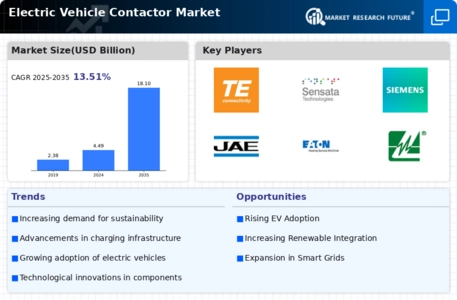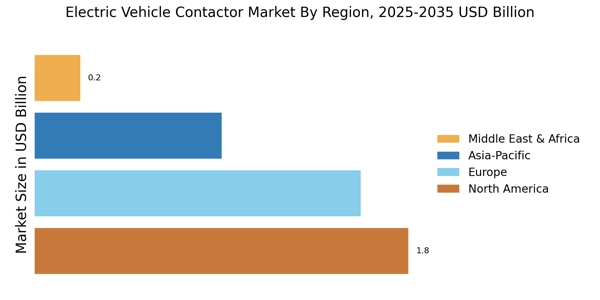Growing Environmental Awareness
The increasing awareness of environmental issues is significantly influencing consumer choices, thereby impacting the Electric Vehicle Contactor Market. As individuals and organizations seek to reduce their carbon footprints, the shift towards electric vehicles becomes more pronounced. This trend is supported by a growing body of research indicating that electric vehicles produce fewer emissions compared to traditional combustion engines. In 2025, it is anticipated that the market for electric vehicles will continue to expand, driven by this heightened environmental consciousness. Consequently, the Electric Vehicle Contactor Market is likely to benefit from this shift, as demand for efficient and sustainable contactor solutions rises.
Rising Demand for Electric Vehicles
The increasing consumer preference for electric vehicles (EVs) is a primary driver for the Electric Vehicle Contactor Market. As more individuals and businesses transition to EVs, the demand for reliable and efficient contactors rises. In 2025, the number of electric vehicles on the road is projected to surpass 30 million units, indicating a robust growth trajectory. This surge necessitates advanced contactor solutions that can handle higher voltages and currents, ensuring safety and performance. Consequently, manufacturers in the Electric Vehicle Contactor Market are focusing on developing innovative products that meet these evolving requirements, thereby enhancing their market position.
Government Incentives and Regulations
Government policies aimed at promoting electric vehicle adoption significantly influence the Electric Vehicle Contactor Market. Various countries have implemented incentives such as tax rebates, grants, and subsidies to encourage consumers to purchase EVs. Additionally, stringent emissions regulations compel automotive manufacturers to invest in electric technologies. For instance, in 2025, several regions are expected to enforce stricter emissions standards, further driving the demand for electric vehicles and, by extension, the contactors that support them. This regulatory environment creates a favorable landscape for the Electric Vehicle Contactor Market, as manufacturers align their offerings with compliance requirements.
Advancements in Charging Infrastructure
The expansion of charging infrastructure is a crucial factor propelling the Electric Vehicle Contactor Market. As the number of electric vehicles increases, the need for accessible and efficient charging solutions becomes paramount. Investments in public and private charging stations are expected to rise, with projections indicating a growth of over 50% in charging points by 2026. This expansion necessitates the integration of advanced contactor technologies that can manage the electrical loads effectively. Consequently, the Electric Vehicle Contactor Market is likely to see heightened demand for products that enhance the reliability and speed of charging operations.
Technological Innovations in Contactors
Technological advancements in contactor design and functionality are reshaping the Electric Vehicle Contactor Market. Innovations such as solid-state contactors and smart contactor systems are emerging, offering enhanced performance and reliability. These technologies enable better energy management and improved safety features, which are critical for electric vehicle applications. As manufacturers invest in research and development, the market is witnessing a shift towards more sophisticated contactor solutions that cater to the specific needs of electric vehicles. This trend is expected to drive growth in the Electric Vehicle Contactor Market, as companies strive to differentiate their products in a competitive landscape.


















Leave a Comment